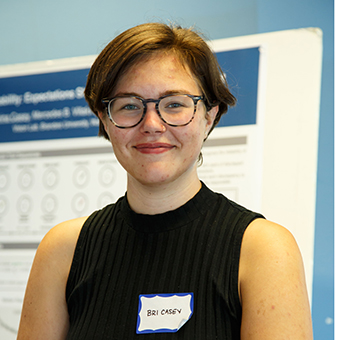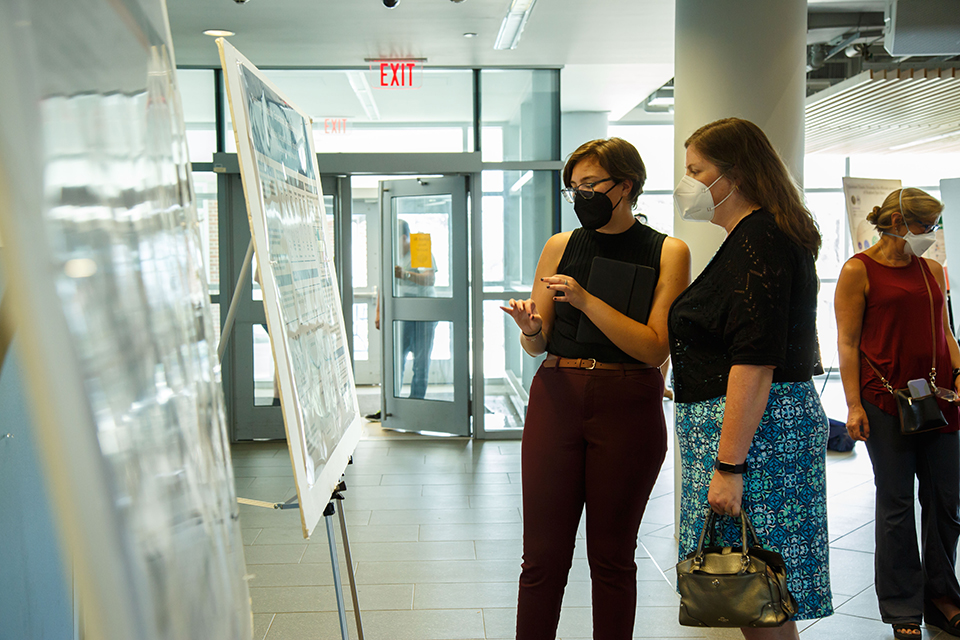Sabrina Casey
Sekuler Lab
Department of Psychology
Brandeis University
Reacting to Unreliability: Expectations Shape Responses to Motion Onset
 Predictability is critical in everyday life. For example, visual detection increases when reality matches internal expectations. To study the effect of unreliable visual information on motion detection in humans, subjects' reaction times to the onset of coherent motion were measured after they received probabilistic information about what they might see.
Predictability is critical in everyday life. For example, visual detection increases when reality matches internal expectations. To study the effect of unreliable visual information on motion detection in humans, subjects' reaction times to the onset of coherent motion were measured after they received probabilistic information about what they might see.
The experiment took the form of a simple video game where randomly moving white dots simulated snowfall. Subjects' task was to detect and respond quickly to a sudden change from random motion in multiple directions to motion in some single direction, as they might experience if there were a wind-driven gust of snow. On most trials, a directional cue preceded the snow. The cue was related stochastically to the direction of the wind-driven snow gust. The cue’s color indicated its precision relative to the direction of the upcoming gust. A green cue preceded a possible wind gust range of +/- 5 degrees centered around the cue, a yellow cue had a range of +/- 90, and a red cue +/- 180.
Following the cue, random motion was presented for an unpredictable time (from 0.5 to 1.5 sec), before all the snow began moving in the same direction: a wind gust. Subjects were required to respond as soon as they detected coherent motion, no judgment was made about motion direction. Both cue type and the length of time prior to the wind gust (random motion) affected reaction times. The most reliable cue produced the fastest response times, as expected. Additionally, a final test was conducted to evaluate subjects’ understanding of the contrast in cue reliability. Subjects were asked to classify differences between cue orientation and the direction of a wind gust by likely cue color.
Results showed learned recognition of the reliability of cues as subjects were generally able to correctly identify which discrepancies corresponded with each type of cue. Greater understanding of how adjustment to, and integration of, differing levels of predictive reliability provides insight into how visual motion information is sorted, and therefore what information we can consciously use.
Personal Statement
I am fascinated by the human experience, particularly understanding how people form beliefs about the world and how to operate within it. My big questions span topics involving the limitations of our senses, such as how, when, and where information sorting occurs, and the impact of attention and memory. In Professor Sekuler’s course, Introduction to Cognitive Neuroscience, I realized the key to these big philosophical questions lies in the study of neuroscience; specifically, perception. Logically, one must uncover how the brain deals with incoming information to understand how cognition operates. I have been involved in the Vision Lab since Summer 2021, supporting projects run by other researchers. Almost a year later, I started my own independent research with a project investigating the impact of coherence on direction detection accuracy and response time. The experience of conducting an experiment from start to finish solidified my love of research.
This summer I was fortunate to ask bigger, deeper questions, focusing on how the brain handles unreliable information. Designing this project was my favorite part of the process, exploring ways to exploit the effect of expectations on responses. The task went through many changes before it took its final form, leading me to re-evaluate my broader goal many times while remaining focused on the many small tasks at hand. Data analysis, on the other hand, was the most daunting step in this process as I have little experience working with raw data. I truly surprised myself with my ability to successfully utilize my resources to accomplish my goals. This research project challenged me to learn even more about my personal work ethic and resilience as I pushed through challenges and adapted to changes, always following the next logical step. I am ecstatic about the foundation I have built, and as I enter my last year at Brandeis, I plan to leverage my work and pursue a senior thesis. Being a M.R. Bauer Foundation Summer Undergraduate Research Fellow has been the highlight of my Brandeis career.
Giving Back Reflection
This summer I was a part of organizing an online rally titled Jews for Abortion Access with the alumnae association of my sorority, Sigma Alpha Epsilon Pi (SAEPi). We created a non-denominational safe space to discuss the Jewish basis for abortion and connect with others interested in reproductive justice.
